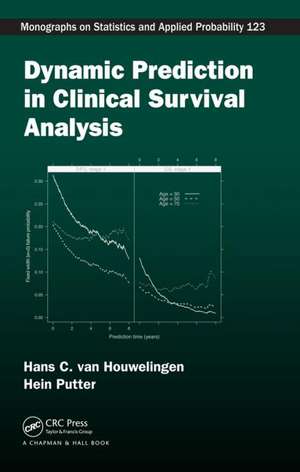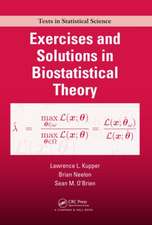Dynamic Prediction in Clinical Survival Analysis: Chapman & Hall/CRC Monographs on Statistics and Applied Probability
Autor Hans van Houwelingen, Hein Putteren Limba Engleză Hardback – 9 noi 2011
Designed to be useful to applied statisticians and clinical epidemiologists, each chapter in the book has a practical focus on the issues of working with real life data. Chapters conclude with additional material either on the interpretation of the models, alternative models, or theoretical background. The book consists of four parts:
- Part I deals with prognostic models for survival data using (clinical) information available at baseline, based on the Cox model
- Part II is about prognostic models for survival data using (clinical) information available at baseline, when the proportional hazards assumption of the Cox model is violated
- Part III is dedicated to the use of time-dependent information in dynamic prediction
- Part IV explores dynamic prediction models for survival data using genomic data
| Toate formatele și edițiile | Preț | Express |
|---|---|---|
| Paperback (1) | 306.13 lei 6-8 săpt. | |
| CRC Press – 14 oct 2024 | 306.13 lei 6-8 săpt. | |
| Hardback (1) | 1115.51 lei 6-8 săpt. | |
| CRC Press – 9 noi 2011 | 1115.51 lei 6-8 săpt. |
Din seria Chapman & Hall/CRC Monographs on Statistics and Applied Probability
- 9%
 Preț: 731.84 lei
Preț: 731.84 lei - 9%
 Preț: 643.15 lei
Preț: 643.15 lei -
 Preț: 373.59 lei
Preț: 373.59 lei - 9%
 Preț: 1243.63 lei
Preț: 1243.63 lei - 9%
 Preț: 645.61 lei
Preț: 645.61 lei -
 Preț: 328.46 lei
Preț: 328.46 lei -
 Preț: 340.84 lei
Preț: 340.84 lei - 8%
 Preț: 396.91 lei
Preț: 396.91 lei -
 Preț: 347.50 lei
Preț: 347.50 lei - 9%
 Preț: 1040.74 lei
Preț: 1040.74 lei - 8%
 Preț: 397.49 lei
Preț: 397.49 lei - 9%
 Preț: 643.59 lei
Preț: 643.59 lei - 20%
 Preț: 689.56 lei
Preț: 689.56 lei - 18%
 Preț: 1111.90 lei
Preț: 1111.90 lei - 9%
 Preț: 606.15 lei
Preț: 606.15 lei - 18%
 Preț: 1118.65 lei
Preț: 1118.65 lei - 18%
 Preț: 1118.99 lei
Preț: 1118.99 lei - 25%
 Preț: 526.38 lei
Preț: 526.38 lei - 25%
 Preț: 427.84 lei
Preț: 427.84 lei -
 Preț: 486.70 lei
Preț: 486.70 lei - 25%
 Preț: 499.81 lei
Preț: 499.81 lei - 15%
 Preț: 674.37 lei
Preț: 674.37 lei - 18%
 Preț: 1280.44 lei
Preț: 1280.44 lei - 23%
 Preț: 376.17 lei
Preț: 376.17 lei - 18%
 Preț: 1156.73 lei
Preț: 1156.73 lei - 18%
 Preț: 1326.99 lei
Preț: 1326.99 lei - 25%
 Preț: 487.34 lei
Preț: 487.34 lei - 28%
 Preț: 876.79 lei
Preț: 876.79 lei - 18%
 Preț: 703.79 lei
Preț: 703.79 lei - 27%
 Preț: 996.14 lei
Preț: 996.14 lei - 22%
 Preț: 413.08 lei
Preț: 413.08 lei - 25%
 Preț: 456.19 lei
Preț: 456.19 lei - 15%
 Preț: 489.26 lei
Preț: 489.26 lei - 18%
 Preț: 760.35 lei
Preț: 760.35 lei - 15%
 Preț: 718.62 lei
Preț: 718.62 lei - 28%
 Preț: 874.74 lei
Preț: 874.74 lei - 18%
 Preț: 919.10 lei
Preț: 919.10 lei - 28%
 Preț: 631.16 lei
Preț: 631.16 lei - 29%
 Preț: 627.88 lei
Preț: 627.88 lei - 27%
 Preț: 1000.51 lei
Preț: 1000.51 lei - 15%
 Preț: 671.64 lei
Preț: 671.64 lei - 15%
 Preț: 676.33 lei
Preț: 676.33 lei - 15%
 Preț: 489.26 lei
Preț: 489.26 lei - 28%
 Preț: 740.04 lei
Preț: 740.04 lei
Preț: 1115.51 lei
Preț vechi: 1360.38 lei
-18% Nou
Puncte Express: 1673
Preț estimativ în valută:
213.46€ • 228.26$ • 177.97£
213.46€ • 228.26$ • 177.97£
Carte tipărită la comandă
Livrare economică 17 aprilie-01 mai
Preluare comenzi: 021 569.72.76
Specificații
ISBN-13: 9781439835333
ISBN-10: 1439835330
Pagini: 250
Ilustrații: 45 Tables, black and white; 91 Illustrations, black and white
Dimensiuni: 178 x 254 x 20 mm
Greutate: 0.64 kg
Ediția:UK edition
Editura: CRC Press
Colecția CRC Press
Seria Chapman & Hall/CRC Monographs on Statistics and Applied Probability
Locul publicării:Boca Raton, United States
ISBN-10: 1439835330
Pagini: 250
Ilustrații: 45 Tables, black and white; 91 Illustrations, black and white
Dimensiuni: 178 x 254 x 20 mm
Greutate: 0.64 kg
Ediția:UK edition
Editura: CRC Press
Colecția CRC Press
Seria Chapman & Hall/CRC Monographs on Statistics and Applied Probability
Locul publicării:Boca Raton, United States
Public țintă
AcademicCuprins
Prognostic models for survival data using (clinical) information available at baseline, based on the Cox model: The special nature of survival data. Cox regression model. Measuring the predictive value of a Cox model. Calibration and revision of Cox models. Prognostic models for survival data using (clinical) information available at baseline, when the proportional hazards assumption of the Cox model is violated: Mechanisms explaining violation of the Cox model. Non-proportional hazards models. Dealing with non-proportional hazards. Dynamic prognostic models for survival data using time-dependent information: Dynamic predictions using biomarkers. Dynamic prediction in multi-state models. Dynamic prediction in chronic disease. Dynamic prognostic models for survival data using genomic data: Penalized Cox models. Dynamic prediction based on genomic data. Appendices: Data sets. Software and website. References. Index.
Notă biografică
Hans van Houwelingen received his Ph.D. in Mathematical Statistics from the University of Utrecht in 1973. He stayed at the Mathematics Department in Utrecht until 1986. In that time his theoretical research interest was empirical Bayes methodology as developed by Herbert Robbins. His main contribution was the finding that empirical Bayes rules could be improved by monitonization.
On the practical side, he was involved in all kinds of collaborations with researchers in psychology, chemistry and medicine. The latter brought him to Leiden in 1986 where he was appointed chair and department head of Medical Statistics at the Leiden Medical School, which was transformed into the Leiden University Medical Center (LUMC) in 1996.
Together with his Ph.D. students he developed several research lines in logistic regression, survival analysis, meta-analysis, statistical genetics and statistical bioinformatics. In the meantime, the department grew into the Department of Medical Statistics and Bioinformatics, which also includes the chair and staff in Molecular Epidemiology.
Dr. van Houwelingen was editor-in-chief of Statistica Neerlandica and served on the editorial boards of Statistical Methods In Medical Research, Lifetime Data Analysis, Biometrics, Biostatistics, Biometrical Journal and Statistics and Probability Letters. He is elected member of ISI, fellow of ASA, honorary member of the Dutch Statistical Society (VVS) and ANed, the Dutch Region of the International Biometric Society (IBS).
Dr. van Houwelingen retired on January 1, 2009. On that occasion he was appointed Knight in the Order of the Dutch Lion.
Hein Putter received his Ph.D. in mathematical statistics from the University of Leiden in 1994, under the supervision of Willem van Zwet, on the topic of resampling methods. After post-doc positions in the Department of Mathematics of the University of Amsterdam and the Free University Amsterdam, and at the Statistical Laboratory of the University of Cambridge, he turned to medical statistics in 1998, working for the HIV Monitoring Fund and the International Antiviral Therapy Evaluation Center (IATEC), based at the Amsterdam Medical Center. In 2000, Dr. Putter was appointed assistant professor in the Department of Medical Statistics and Bioinformatics of the Leiden University Medical Center.
Dr. Putter’s research interests include: statistical genetics, dynamical models in HIV and survival analysis—in particular competing risks and multi-state models. Dr. Putter collaborates closely with the Department of Surgery and the Department of Oncology of the LUMC, and with international organizations like the European Organisation for the Research and Treatment of Cancer (EORTC) and the European Group for Blood and Marrow Transplantation (EBMT). He serves as associate editor of Statistics and Probability Letters and Statistics in Medicine, and he was guest editor of special issues of Biometrical Journal and Journal of Statistical Software. He was one of the initiators of the IBS Channel Network.
In 2010, Dr. Putter was appointed full professor in the Department of Medical Statistics and Bioinformatics of the LUMC.
On the practical side, he was involved in all kinds of collaborations with researchers in psychology, chemistry and medicine. The latter brought him to Leiden in 1986 where he was appointed chair and department head of Medical Statistics at the Leiden Medical School, which was transformed into the Leiden University Medical Center (LUMC) in 1996.
Together with his Ph.D. students he developed several research lines in logistic regression, survival analysis, meta-analysis, statistical genetics and statistical bioinformatics. In the meantime, the department grew into the Department of Medical Statistics and Bioinformatics, which also includes the chair and staff in Molecular Epidemiology.
Dr. van Houwelingen was editor-in-chief of Statistica Neerlandica and served on the editorial boards of Statistical Methods In Medical Research, Lifetime Data Analysis, Biometrics, Biostatistics, Biometrical Journal and Statistics and Probability Letters. He is elected member of ISI, fellow of ASA, honorary member of the Dutch Statistical Society (VVS) and ANed, the Dutch Region of the International Biometric Society (IBS).
Dr. van Houwelingen retired on January 1, 2009. On that occasion he was appointed Knight in the Order of the Dutch Lion.
Hein Putter received his Ph.D. in mathematical statistics from the University of Leiden in 1994, under the supervision of Willem van Zwet, on the topic of resampling methods. After post-doc positions in the Department of Mathematics of the University of Amsterdam and the Free University Amsterdam, and at the Statistical Laboratory of the University of Cambridge, he turned to medical statistics in 1998, working for the HIV Monitoring Fund and the International Antiviral Therapy Evaluation Center (IATEC), based at the Amsterdam Medical Center. In 2000, Dr. Putter was appointed assistant professor in the Department of Medical Statistics and Bioinformatics of the Leiden University Medical Center.
Dr. Putter’s research interests include: statistical genetics, dynamical models in HIV and survival analysis—in particular competing risks and multi-state models. Dr. Putter collaborates closely with the Department of Surgery and the Department of Oncology of the LUMC, and with international organizations like the European Organisation for the Research and Treatment of Cancer (EORTC) and the European Group for Blood and Marrow Transplantation (EBMT). He serves as associate editor of Statistics and Probability Letters and Statistics in Medicine, and he was guest editor of special issues of Biometrical Journal and Journal of Statistical Software. He was one of the initiators of the IBS Channel Network.
In 2010, Dr. Putter was appointed full professor in the Department of Medical Statistics and Bioinformatics of the LUMC.
Recenzii
"It offers several original viewpoints that make it a worthwhile addition to the literature. … For the researcher wishing to gain knowledge of survival analysis beyond that of standard introductions, this is an excellent book. It contains a lot of very useful procedures and demonstrates them in practical applications on real data from the authors’ own experience. The datasets are described in Appendix A and most of the data are available from the package dynpred (Appendix B), which also contains suitable software. On the book’s website one may find R code for each chapter in the book; this is a highly useful feature. Output and plots are also available, which makes the book useful for teaching purposes."
—Odd O. Aalen, Journal of the American Statistical Association, September 2014, Vol. 109
—Odd O. Aalen, Journal of the American Statistical Association, September 2014, Vol. 109
Descriere
In the last twenty years, dynamic prediction models have been extensively used to monitor patient prognosis in survival analysis. Written by one of the pioneers in the area, this book synthesizes these developments in a unified framework. It covers a range of models, including prognostic and dynamic prediction of survival using genomic data and time-dependent information. The text includes numerous examples using real data taken from the authors’ collaborative research. R programs are provided for implementing the methods.











